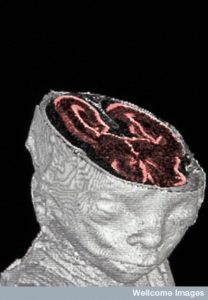 The development of the human brain involves orchestration of thousands of different kinds of cells in an array of trillions. A vast range of molecular and cellular processes operate in brain development over a very long period of time—the longest of all primates. Humans, also, have a longer childhood and adolescence for continued brain development. Because of the long time frame, environment and education can greatly affect the end results. Of all regions, the human cortex is the most unique in nature. Currently, there is an increasing understanding of unique events that occur in the development of the human cortex. Research is beginning to show how human brains are built.
The development of the human brain involves orchestration of thousands of different kinds of cells in an array of trillions. A vast range of molecular and cellular processes operate in brain development over a very long period of time—the longest of all primates. Humans, also, have a longer childhood and adolescence for continued brain development. Because of the long time frame, environment and education can greatly affect the end results. Of all regions, the human cortex is the most unique in nature. Currently, there is an increasing understanding of unique events that occur in the development of the human cortex. Research is beginning to show how human brains are built.

The human brain starts as a tube and then becomes fantastically organized. It produces special regions of increased stem cell activity, with many more diverse stem cells than other species. Such complicated activity allows for more problems and more types of brain diseases to develop. With such great differences from other species, it is not really possible to understand the development of the human brain by studying other animals. Recent research into human stem cells has contributed to our current understanding.
The Human Brain Has Fantastic Amount of Cells And Connections
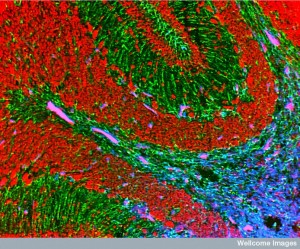 Adults have approximately 86 billion neurons including the brain and spinal cord. There are another 100 billion glial cells.The cortex has 16 billion neurons and 160 trillion synapses. In the entire brain there are hundreds of trillions of synapses. It is very hard to believe, but it has been calculated there are 100,000 miles of myelinated axons in each brain. To support this massive enterprise, the adult brain uses 20% of all energy while being 2.5% of weight.
Adults have approximately 86 billion neurons including the brain and spinal cord. There are another 100 billion glial cells.The cortex has 16 billion neurons and 160 trillion synapses. In the entire brain there are hundreds of trillions of synapses. It is very hard to believe, but it has been calculated there are 100,000 miles of myelinated axons in each brain. To support this massive enterprise, the adult brain uses 20% of all energy while being 2.5% of weight.
The fetus uses much more energy for the brain, since it is manufacturing cells at a fantastic pace. In the fetus, 3.8 million new neurons are minted each hour for the cortex and 4.6 million for the entire brain. In late fetal life, 42 million synapses are formed each minute in the cortex. How can so many cells be produced, specified and placed in circuits?
Human Brain Development
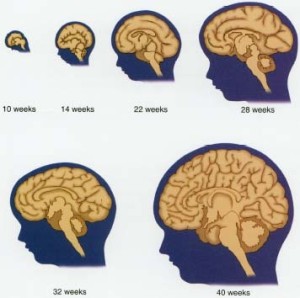 The brain starts developing first of all organs and finishes last around age 30. It grows faster than any organ from the 4th week of the fetus and continues for years. After this, it slows down and most of the energy is focused on synapses, myelin, circuits, pruning and neuroplasticity. Many structures are temporary, such as specific types of stem cells and differentiated cells and the unique remodeling of circuits and cellular compartments.
The brain starts developing first of all organs and finishes last around age 30. It grows faster than any organ from the 4th week of the fetus and continues for years. After this, it slows down and most of the energy is focused on synapses, myelin, circuits, pruning and neuroplasticity. Many structures are temporary, such as specific types of stem cells and differentiated cells and the unique remodeling of circuits and cellular compartments.
In the first eight weeks, the ectoderm develops a notochord and then the neural plate and the neural groove. Neural folds fuse to form the neural tube. Neuropores at each end close and form the ventricular fluid systems out of the amniotic fluid. The tube forms three basic bulges that become the forebrain, the midbrain and the hindbrain and the lower spinal cord. All along the tube, very specific stem cells are produced that will form the many different kinds of brain cells.
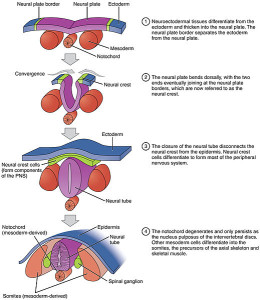
In the next part of the fetal period, there is explosive growth everywhere to make it 40 times larger. This expansion includes vast specifications of different kinds of cells. The cerebral hemispheres appear and grow immensely, producing sulci and gyri. By birth, the brain looks very much like the adult brain, except that the cerebellum grows much more afterward.
After birth is when the glial cells grow massively. Just after birth there is massive development of dendrites, axons and synapses and then myelination starts in the cerebellum and forebrain. A previous post showed that unique small regions are myelinated early related to understanding language (see post What do Infants Know about this very recent finding). The infant’s brain will grow 4 times bigger by late adolescence, but most of it occurs in the first three years. It is during this time that the structural and molecular changes occur. Stem cells produce both neurons and microglia.
During development, 80% of all neurons are excitatory glutamate types, which are all produced by stem cells in the VZ (ventricular zone) and SVZ (sub ventricular zone) regions. Most of the rest are inhibitory GABA, which come from a region called the ventral telecephalon during fetal development. Cerebellar cells are generated in the first year after birth.
New Stimulatory and Inhibitory Neurons Are Produced
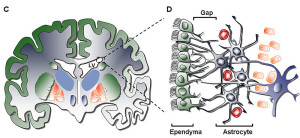
The first neurons come from the VZ in the cortical plate, where later the cortex layers 2 to 6 will occur. The SVZ then emerges and becomes much bigger. Both produce all of the excitatory neurons and then all of the glial cells.
Some of these stem cells transform into radial glia (RG) stem cells, which create a long process that spans the entire width of the brain. These RG cells are responsible for much of the massive increase in size and it accounts for the different sizes in different animals. These long bipolar cells produce neurons, astrocytes and oligodendrocytes and serve as scaffolding for travel.
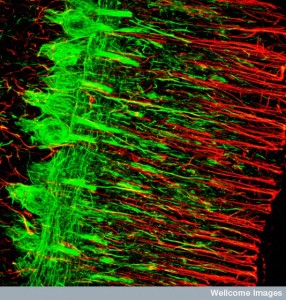 New neurons are produced in the human brain much longer than in other mammals. For example, the cortex plate makes new cells for two weeks in mice, two months in macaque monkeys and four months in humans. Many of the new neurons build temporary brain structures that are later altered and expanded after many more neurons are produced. There are many different stem cells created that migrate in very specific ways. The large number of glutamate excitatory neurons start from particular stem cells in the dorsal pallium and migrate to the “cortical plate.”
New neurons are produced in the human brain much longer than in other mammals. For example, the cortex plate makes new cells for two weeks in mice, two months in macaque monkeys and four months in humans. Many of the new neurons build temporary brain structures that are later altered and expanded after many more neurons are produced. There are many different stem cells created that migrate in very specific ways. The large number of glutamate excitatory neurons start from particular stem cells in the dorsal pallium and migrate to the “cortical plate.”
GABA inhibitory interneurons travel a completely different path to the same plate. This is interesting since it is the dynamic of stimulation and inhibition that is critical for cognition. These very first stem cells actually start in a completely different region and travel to the VZ where all of this huge expansion occurs. There are many very different unique stem cells made at this time that start creating the early circuits with synapses. In fact, each area of this primordial structure splits into different types of stem cells for future expansion.
Sub Plate – Temporary Human Brain Structure
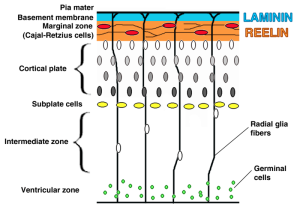 One of the unique temporary structures is called a “future sub plate (SP) that grows enormously and becomes the largest fetal part of the neo cortex. This completely temporary structure then produces many new types of stem cells. These stem cells grow into a large array of regions that form the adult neural circuits, such as particular circuits that go into the cortex in various regions. This temporary structure has unique elaborate extracellular matrix and has many different kinds of neurons.
One of the unique temporary structures is called a “future sub plate (SP) that grows enormously and becomes the largest fetal part of the neo cortex. This completely temporary structure then produces many new types of stem cells. These stem cells grow into a large array of regions that form the adult neural circuits, such as particular circuits that go into the cortex in various regions. This temporary structure has unique elaborate extracellular matrix and has many different kinds of neurons.
The temporary SP has ancestors of later cortex pyramidal neurons, GABA inhibitory interneurons and many different glial cells. Many other types of neurons travel through the SP to other regions. As well, a large number of synapses are made that are later altered completely. This completely temporary fetal structure, the sub plate, with no relation to the future adult structures, has almost 4 billion neurons—more than the entire brain of rats and many other mammals.
The SP can be damaged and cause many problems. The SP gradually vanishes in late pregnancy to early infancy, but many of the neurons remain, moved into other adult structures. Other temporary structures include the marginal zone and cortical plate, which join with the SP to morph into the human cortex.
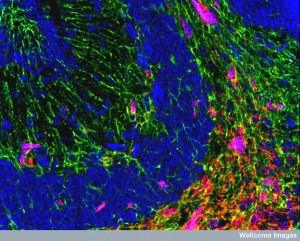 The large temporary structure waits for incoming neurons and starts some outgoing neurons. It accepts the first connections from the thalamus, which go to what becomes layer 4 of the cortex. Later, many other sensory neurons will follow this path to layer 4, establishing the visual system. The SP is different in humans than any other animal. The wiring patterns that are developed are vital for later correct wiring, but these neurons all disappear. A previous post noted that most of the early connections between neurons are electrical synapses and later chemical synapses are built on that pattern.
The large temporary structure waits for incoming neurons and starts some outgoing neurons. It accepts the first connections from the thalamus, which go to what becomes layer 4 of the cortex. Later, many other sensory neurons will follow this path to layer 4, establishing the visual system. The SP is different in humans than any other animal. The wiring patterns that are developed are vital for later correct wiring, but these neurons all disappear. A previous post noted that most of the early connections between neurons are electrical synapses and later chemical synapses are built on that pattern.
Adult Brain Takes Shape
 The adult brain begins to form when projection neurons travel to form the layers of the cortex—starting on the inside and then building to the outside. When neurons have travelled to particular spots, they have instructions to change into the particular cells that are needed there. The neuron then takes a particular shape and position and it is only after this that dendrites and axons are produced. It is only in the final locations that the synapses form.
The adult brain begins to form when projection neurons travel to form the layers of the cortex—starting on the inside and then building to the outside. When neurons have travelled to particular spots, they have instructions to change into the particular cells that are needed there. The neuron then takes a particular shape and position and it is only after this that dendrites and axons are produced. It is only in the final locations that the synapses form.
Glial Cells
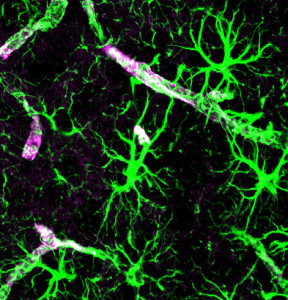 Glial cells form after neurons have started expanding. At birth, many of the glial cells are formed. They continue to be produced after birth in large numbers (oligodendrocytes continue to be produced throughout life to produce myelin throughout the brain – see post Myelin Facilitation of Whole Brain Neuroplasticity). Astrocytes and oligodendrocytes are produced by RG stem cells. A large number of oligodendrocytes are produced in the first three years and they travel widely in the brain making myelin. They continue to multiply for thirty years in all areas where there is myelin. In chimps, myelin is mostly formed in adolescence.
Glial cells form after neurons have started expanding. At birth, many of the glial cells are formed. They continue to be produced after birth in large numbers (oligodendrocytes continue to be produced throughout life to produce myelin throughout the brain – see post Myelin Facilitation of Whole Brain Neuroplasticity). Astrocytes and oligodendrocytes are produced by RG stem cells. A large number of oligodendrocytes are produced in the first three years and they travel widely in the brain making myelin. They continue to multiply for thirty years in all areas where there is myelin. In chimps, myelin is mostly formed in adolescence.
 Oligodendrocytes continue to grow throughout life for neuroplasticity. They represent the greatest number of new brain cells throughout adult life. Recent research shows that myelin is closely tied to neuroplasticity. Myelin has direct effects on inhibiting synapses. This effect is closely tied to learning, memory and the development of detailed perceptions.
Oligodendrocytes continue to grow throughout life for neuroplasticity. They represent the greatest number of new brain cells throughout adult life. Recent research shows that myelin is closely tied to neuroplasticity. Myelin has direct effects on inhibiting synapses. This effect is closely tied to learning, memory and the development of detailed perceptions.
Astrocytes start with RG cells, but then develop their own stem cells that produce great numbers. The early astrocytes appear as adult mature cells. But, they multiply greatly for three years during the time when the majority of synapses are formed and then many of them pruned.
Cortex Lateralization
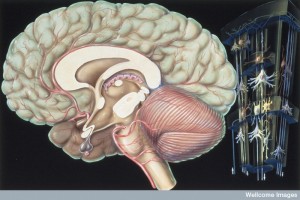 In order for the three dimensional structure of the cortex to be formed, cells need to be able to be in their proper coordinates—radial direction and tangent plane. This information is somehow expressed in genetic networks through transcription factors. Cells, also, respond to signals from axons from the thalamus. This very detailed layered structure is maintained because of different types of neurons in specific placements, which are defined by connections to incoming and outgoing axon connections.
In order for the three dimensional structure of the cortex to be formed, cells need to be able to be in their proper coordinates—radial direction and tangent plane. This information is somehow expressed in genetic networks through transcription factors. Cells, also, respond to signals from axons from the thalamus. This very detailed layered structure is maintained because of different types of neurons in specific placements, which are defined by connections to incoming and outgoing axon connections.
 Different layers of pyramidal cells are first determined by the sequence of birth of the neurons involved, the first taking the positions at the deepest position and then layer upon layer until the last are on the outside, which are the superficial layers 2 and 3. This last set of layers is particularly human, making mostly highly local cortical connections, which relate to cognition and motor capacities, special to humans.
Different layers of pyramidal cells are first determined by the sequence of birth of the neurons involved, the first taking the positions at the deepest position and then layer upon layer until the last are on the outside, which are the superficial layers 2 and 3. This last set of layers is particularly human, making mostly highly local cortical connections, which relate to cognition and motor capacities, special to humans.
The basic neuronal structures are very similar on the right and left neo cortex, but with a a slight asymmetry. Later, this becomes more prominent with language. A previous post about new research on infants shows there is already some subtle, but important, lateralization related to language at birth. Research shows there is definite asymmetry in the later fetal life. The right grows faster and the asymmetry becomes greater after birth.
Circuits
 Halfway through pregnancy, newly born neurons have some dendrites and start making axons. This process increases through birth where dendrite arbors are formed and many more axons and synapses are formed. What is complex is that the patterns of arbors and connections are quite different in each region, each type of neuron, each subtype, and each layer—making it unbelievably complex. The creation of synapses follows a definite sequence from the spinal region related to reflexes; then the cortex wall develops; then the SP and the developing CP plate.
Halfway through pregnancy, newly born neurons have some dendrites and start making axons. This process increases through birth where dendrite arbors are formed and many more axons and synapses are formed. What is complex is that the patterns of arbors and connections are quite different in each region, each type of neuron, each subtype, and each layer—making it unbelievably complex. The creation of synapses follows a definite sequence from the spinal region related to reflexes; then the cortex wall develops; then the SP and the developing CP plate.
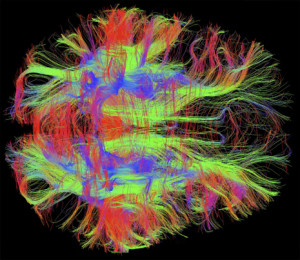 The SP has a large amount of synapses while it waits for connections to come to connect with the future cortex. Then pyramidal synapses appear. After this, a large amount of sensory connections from the thalamus invade the cortex with axons and synapses. Much later the inhibitory interneurons appear with connections. It is the huge invasion of thalamic sensory axons that stimulates large dendrite arbors in the cortex, especially in layers 3 and 5. This huge growth defines the final 6 layers of the cortex. They then expand greatly, but most are transient. The real connections start close to birth.
The SP has a large amount of synapses while it waits for connections to come to connect with the future cortex. Then pyramidal synapses appear. After this, a large amount of sensory connections from the thalamus invade the cortex with axons and synapses. Much later the inhibitory interneurons appear with connections. It is the huge invasion of thalamic sensory axons that stimulates large dendrite arbors in the cortex, especially in layers 3 and 5. This huge growth defines the final 6 layers of the cortex. They then expand greatly, but most are transient. The real connections start close to birth.
Too many neurons are grown in the first two years—different in each cortical region. Then, the pruning is a massive undertaking during the first years after birth. This remodeling of the entire brain is critical to develop the adult form of the brain. The regions that combine senses and motor activity have pruning and increased myelin production for decades. This explains child like behavior in some late adolescents.
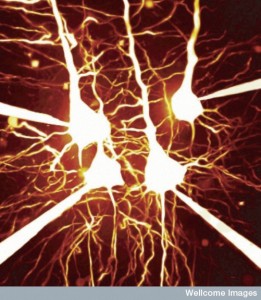 One unusual finding is that pyramidal cortex neurons (neurons that direct behavior, including cognition and movement) grow larger and dendrites grow longer in the first few years. They develop their characteristic shapes with a single large apical dendrite (from the apex of the soma) with more branches further away from the soma. Then five basal dendrites come out of the base of the pyramidal shaped cell body. Further from the cell bodies huge trees are produced.
One unusual finding is that pyramidal cortex neurons (neurons that direct behavior, including cognition and movement) grow larger and dendrites grow longer in the first few years. They develop their characteristic shapes with a single large apical dendrite (from the apex of the soma) with more branches further away from the soma. Then five basal dendrites come out of the base of the pyramidal shaped cell body. Further from the cell bodies huge trees are produced.
They continue to grow larger for five years. These neurons have an extreme bout of pruning and remodeling of circuits. These changes are often correlated with the different cognition and behavior of children as they grow. Also, abnormalities in these circuits appear to correlate with some psychiatric illness.
Genetic Networks and Clusters To Build a Brain
 The mechanisms of the fantastic array of changes described above are just now being researched. Clearly, it is the genetic networks in each type of stem cell and differentiated cell that determines the type of cell it becomes. It is still difficult to imagine how cells understand what circuits to build.
The mechanisms of the fantastic array of changes described above are just now being researched. Clearly, it is the genetic networks in each type of stem cell and differentiated cell that determines the type of cell it becomes. It is still difficult to imagine how cells understand what circuits to build.
Studies are now focused on where different RNAs exist in specific brain regions. It was noted in a previous post that alternate splicing of messenger RNA is used dramatically more in the human brain compared to all other brains. Clearly, RNAs have important impacts on the unique human neo cortex. Also, epigenetics and other elements that regulate the use of DNA are critical to understanding how the brain is built so uniquely in each region.
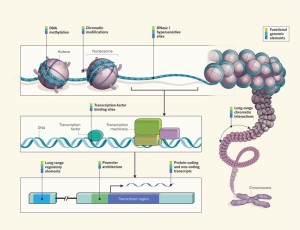 There are 46 human chromosomes with a total of around 6 DNA billion base pairs (letters in the DNA code). The word “gene” has changed its meaning recently and is considered by some to include DNA that produces proteins (from RNA) as well as DNA that produces RNA that has functional effects without making proteins. Approximately 20,000 protein genes exist with another 40,000 genes that make only RNA but not protein (non coding RNA or ncRNA). Much of this non-coding RNA regulates the genetic activity in making RNAs and proteins. Recent research has found 400,000 particles that enhance DNA production and 70,000 promoters that trigger DNA production. Each type of cell (each type of neuron) has different promoters, enhancers and other RNAs.
There are 46 human chromosomes with a total of around 6 DNA billion base pairs (letters in the DNA code). The word “gene” has changed its meaning recently and is considered by some to include DNA that produces proteins (from RNA) as well as DNA that produces RNA that has functional effects without making proteins. Approximately 20,000 protein genes exist with another 40,000 genes that make only RNA but not protein (non coding RNA or ncRNA). Much of this non-coding RNA regulates the genetic activity in making RNAs and proteins. Recent research has found 400,000 particles that enhance DNA production and 70,000 promoters that trigger DNA production. Each type of cell (each type of neuron) has different promoters, enhancers and other RNAs.
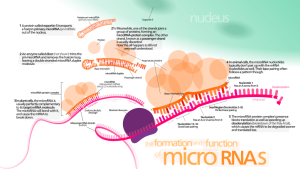 Massive studies are compiling which RNAs makes proteins in each brain region at each time sequence in fetal life. RNAs are different with many specific functions in many different brain regions and at many different times in the developmental process. Most of the proteins that can possibly be made are produced for the development of the brain (86%). The non-coding RNAs are a work in progress since they were considered to be “junk” until recently (when the ENCODE study found otherwise in 2010 – see post). There probably are many more to be discovered.
Massive studies are compiling which RNAs makes proteins in each brain region at each time sequence in fetal life. RNAs are different with many specific functions in many different brain regions and at many different times in the developmental process. Most of the proteins that can possibly be made are produced for the development of the brain (86%). The non-coding RNAs are a work in progress since they were considered to be “junk” until recently (when the ENCODE study found otherwise in 2010 – see post). There probably are many more to be discovered.
Most of the recently found non coding RNAs are used to build the brain. Almost all of the genes (90%) are used differently in each brain region and at each different stage. These differences are much greater than any differences found for gender, individuals and ethnicities. Therefore, the vast genetic networks that operate in uniquely timed sequences occur in all brains. The changes in genetic networks are most massive in the fetal period, which is not surprising. Later, changes that occur in twenty years of middle age are very slight in comparison.
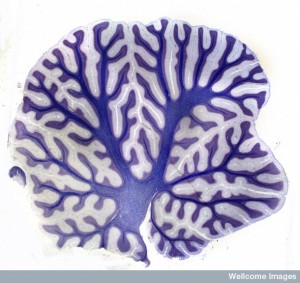 Among the amygdala, hippocampus and neocortex, the cerebellum (motor habit memory) has the most variations of genetic networks and the most unique networks. The next most complex is the thalamus (input of sensory data) and the striatum (more higher level motor functions, reward centers and much more). The cortex is the least, which is not surprising since cognition grows over many years.
Among the amygdala, hippocampus and neocortex, the cerebellum (motor habit memory) has the most variations of genetic networks and the most unique networks. The next most complex is the thalamus (input of sensory data) and the striatum (more higher level motor functions, reward centers and much more). The cortex is the least, which is not surprising since cognition grows over many years.
Some genetic networks only operate at particular periods of time in all regions. Some large networks work for long periods, mainly in infancy, childhood and adolescence. The regional behavior during development coincides with particular types of very complex genetic programs. The cells themselves and their functions change in each period. The cellular changes are shapes, sizes and types of axons and dendrites.
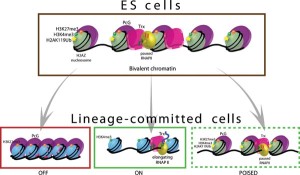 The gene networks operate in clusters that start up in many places at once and coordinate the complex changes that are occurring in structure and function. The two largest clusters that have been identified are present in many places during particular developmental phases. One of these appears to be determining the many different types of stem cells that appear at each location in the developing brain. These stem cells then create particular neurons (out of the at least 1000 types – see post How many Different Kinds of Neurons Are There) that produce an entire lineage of many different diverse cells in that region.
The gene networks operate in clusters that start up in many places at once and coordinate the complex changes that are occurring in structure and function. The two largest clusters that have been identified are present in many places during particular developmental phases. One of these appears to be determining the many different types of stem cells that appear at each location in the developing brain. These stem cells then create particular neurons (out of the at least 1000 types – see post How many Different Kinds of Neurons Are There) that produce an entire lineage of many different diverse cells in that region.
The other largest cluster is related to forming of synapses and ion channels and this one starts later in the fetal period correlated with the explosion of synapses. There are differences found in these clusters related to autism and fragile X. These studies correlate alterations in prefrontal and cortex for primary motor and sensation in mid fetal stage with autism and the frontal region with schizophrenia.
So Many Unique Stem Cells
 The creation of so many unique stem cells is the key to the brain’s complex development. Studies comparing genetic details related to stem cells in humans and other animals find some particular factors and receptors that only exist in humans that are critical to the stem cell process. These studies found 56 genes related to stem cells that are only in humans, not chimps. These were involved in creating many more types of stem cells and a greater volume of cells. These studies show that new genetic clusters in humans are associated with more diverse stem cells and types of neurons. Many of these new types of neurons have unique behavior as well.
The creation of so many unique stem cells is the key to the brain’s complex development. Studies comparing genetic details related to stem cells in humans and other animals find some particular factors and receptors that only exist in humans that are critical to the stem cell process. These studies found 56 genes related to stem cells that are only in humans, not chimps. These were involved in creating many more types of stem cells and a greater volume of cells. These studies show that new genetic clusters in humans are associated with more diverse stem cells and types of neurons. Many of these new types of neurons have unique behavior as well.
Many of the gene clusters in neurons were similar across primates and some mammals in terms of the layering of the cortex cells. But, many are not and correlate with unique human neo cortex structures. The critical transient SP region that later morphs into the neo cortex, has many similar and many different clusters compared with other animals.
 Information has been gleaned about the laminar structure of the cortex, but the connections that are a tangent to other regions are far more complex and extremely unique in humans. Each small area of the cortex has substantial differences in the genetic clusters that are not understood. Both the region and the timing of the clusters are different in each small sub region.
Information has been gleaned about the laminar structure of the cortex, but the connections that are a tangent to other regions are far more complex and extremely unique in humans. Each small area of the cortex has substantial differences in the genetic clusters that are not understood. Both the region and the timing of the clusters are different in each small sub region.
The genetic clusters are particularly unique in the middle of pregnancy and they show preparation for the huge burst at the pre frontal regions. There are differences that later become temporal, occipital and ventro-medial cortex, which are the most “human” regions. These genetic differences subsided by birth. Possibly these are because of the incredibly intricate cortex structures and connections come later.
These clusters are different from other primates. The glial development and the growth of synapses that occur after this are more similar to the adult brain than the unique transient fetal brain. These findings show that the genetic programs in exact 3D spatial and time sequences are related to the unique cell types and circuits that develop in the human cortex.
Epigenetics Plays Critical Roles
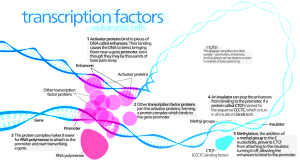
The triggering of the gene clusters at exactly timed sequences and in the exact locations are part of the vast regulation of genes. It involves many players. Once clusters are triggered however, the strength of that production is regulated by a variety of molecules that increase production of a particular molecule (enhancers and promoters), that stop the production (silencers) and that alter the relationship of promoters and enhancers (insulators).
These regulatory molecules themselves have places for multiple other molecules to bind. They are generally called transcription factors. Some of these change the three dimensional shape of the DNA, bringing some of these various landing sites closer together where they can interact in various ways. It was mentioned above that are at least 400,00 different enhancers now known. There are, also, complexes of assembled proteins that alter the shapes of the DNA, much like an enzyme brings two molecules together to better stimulate a reaction. These bring enhancers and promoters together that increase the amount of production.
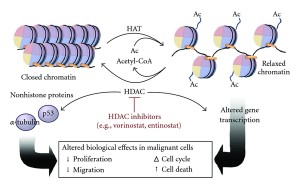 But, along with these, the epigenetic tags have very complex and important interactions as well. There are now more than forty different kinds of tags that are placed on DNA and histones that affect these processes. The most well known are methyl and acetyl groups in various specific stops in DNA and histone, but there are many others.
But, along with these, the epigenetic tags have very complex and important interactions as well. There are now more than forty different kinds of tags that are placed on DNA and histones that affect these processes. The most well known are methyl and acetyl groups in various specific stops in DNA and histone, but there are many others.
About half of the epigenetic tags currently known are present in mice. A very large number are unique to humans. Individual examples of these are now being studied and each is complex and labor intensive to decipher. There are several found that are similar in primates. But, there are many examples of dramatically different systems for the stem cells of the human neo cortex—some related to language, speech and other cognitive abilities of humans. It is clear that many of these regulatory elements are unique to human brains and were drivers of the development. New human regulatory factors are related to stem cell production of neurons and glia, the migration of the neurons into their places and the architecture of the cortex
 The epigenetic tags combine with all the other factors including non coding RNAs and the 3D alterations of chromatin that affect the production of particular clusters of genes. Recent research shows that these epigenetic tags can all respond to stimulation from outside as well (the well known idea of experience modeling brain structures). For example the addition of a methyl group to the cysteine code of DNA seems to be a critical stimulus of cortex development.
The epigenetic tags combine with all the other factors including non coding RNAs and the 3D alterations of chromatin that affect the production of particular clusters of genes. Recent research shows that these epigenetic tags can all respond to stimulation from outside as well (the well known idea of experience modeling brain structures). For example the addition of a methyl group to the cysteine code of DNA seems to be a critical stimulus of cortex development.
Methyl tags on DNA related to the cortex are altered many times during fetal development, but then become less variable after birth. Similar dramatic findings have been described with both methyl and acetyl tags on histone molecules.
Non Coding RNAs

Significant RNAs that have vital effects on regulation of DNA and proteins are categorized as long or short. (See post on Intelligent RNAs Small Large.) The very short ones, called micro RNA (miRNA) alter the messenger RNA as it is making proteins. The large ones can have dramatic global effects on entire regions of DNA. These are major regulators and interact with all the other factors that may bind onto the long RNAs as they sit near the DNA and histones in the 3D chromatin structure. All of these many types of RNAs have important effects on brain development in timed sequences and in particular regions in the cortex and cerebellum in humans and other primates.
To make things even more complex, jumping genes (see post) have also been implicated as part of this regulation, particular for the human brain. These mobile DNA particles function at times as regulating and transcription factors for other DNA.
How Human Brains are Built
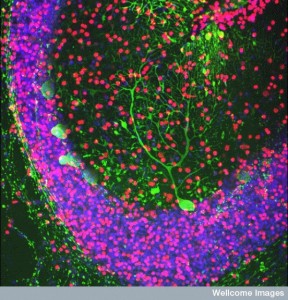 There is such complexity in the process of human brain development, that it will be a long time before details will be known, such as the fantastic array of specific stem cells that appear at precise times and places and produce special cell lineages. But, even if we understand how stem cells determine exact types of neurons and glia in precise timing and locations through the vast regulation of genetic clusters, will this tell us how mind is related?
There is such complexity in the process of human brain development, that it will be a long time before details will be known, such as the fantastic array of specific stem cells that appear at precise times and places and produce special cell lineages. But, even if we understand how stem cells determine exact types of neurons and glia in precise timing and locations through the vast regulation of genetic clusters, will this tell us how mind is related?
The vast instantaneous changes that occur with any mental event must be related to all of these molecular changes at many orders of magnitude at the same moment. Where is the direction for all of this? No reasonable person can think this is a random process. Isn’t it mind that interacts with every cell, every region and every molecule in the brain? How else could this be coordinated on such a global scale?